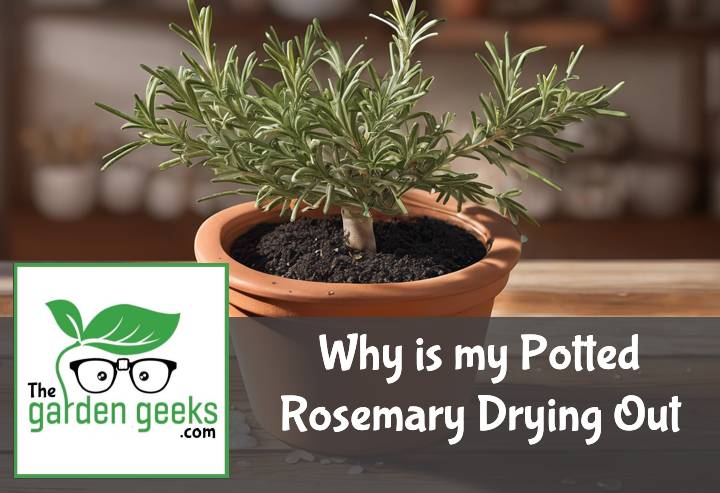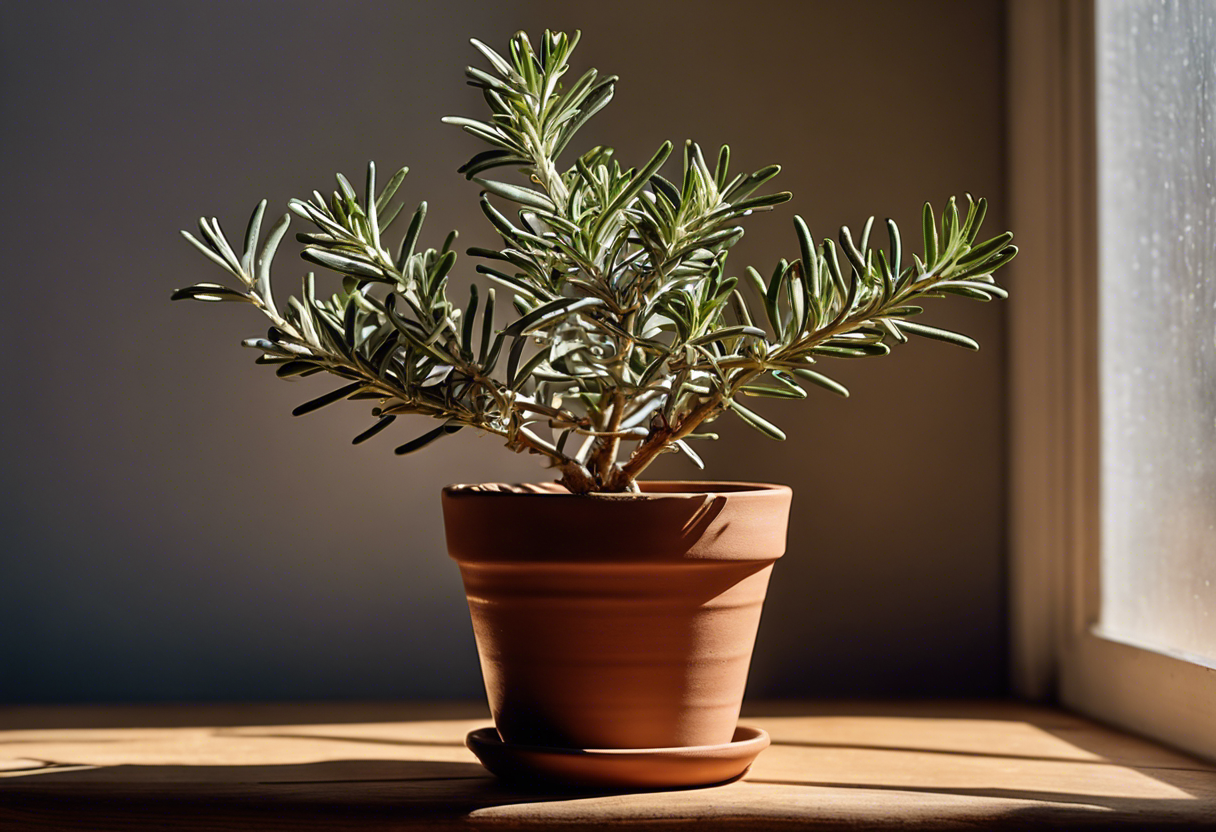Ever found yourself scratching your head, wondering why your beloved Potted Rosemary is Drying Out? Trust me, I’ve been there. It’s like watching your favorite sitcom character getting written off the show – heartbreaking!
But don’t hit the panic button just yet. There are several reasons why this might be happening and, thankfully, a bunch of solutions to get your green buddy back in shape. So, stick around as we unravel this mystery together. Keep reading about ‘Why is my Potted Rosemary Drying Out?’
Key Takeaways
- Potted rosemary dries out due to improper watering, inadequate sunlight, or poor soil conditions.
- Overwatering can cause root rot, leading to dry and brittle branches. Water only when the top inch of soil is dry.
- Rosemary needs at least 6 hours of sunlight daily. Lack of light can cause drying.
- The plant prefers well-draining soil. Heavy, waterlogged soils can lead to drying out.
- Regularly check for pests and diseases that may cause the plant to dry out.
What is Rosemary and How Does it Grow?
Rosemary, a popular herb known for its fragrant aroma and distinct flavor, is a staple in many gardens. It’s a hardy plant that can withstand various conditions, but when it comes to Potted Rosemary growth, things can get a bit tricky.
Understanding the Nature of Rosemary
Originating from the Mediterranean region, rosemary is used to warm climates and well-drained soil. Its physical attributes include needle-like leaves and flowers that range from pink to purple.
In different environments, this evergreen shrub shows diverse behaviors. In its natural habitat, it thrives under full sun exposure and dry conditions. However, when grown indoors or in pots, rosemary requires more attention to mimic these conditions.
Ideal Growing Conditions for Potted Rosemary
When growing potted rosemary, light plays a crucial role. The plant needs at least six hours of direct sunlight daily. So if you’re keeping it indoors, placing it near a south-facing window would be ideal.
Temperature-wise, rosemary prefers cooler nights and warmer days – mimicking its Mediterranean roots. A range between 60-70°F during the day and 50-60°F at night works best.
As for soil type, well-draining soil is key to prevent your Potted Rosemary Drying Out. Overwatering or waterlogged soil can lead to root rot which causes drying out.
Lastly, watering needs vary depending on the environment. Generally speaking though, allowing the top inch of soil to dry out before watering again helps maintain healthy moisture levels without over-saturating the plant.
Why is Your Potted Rosemary Drying Out?
Hey there, green thumb! If you’re wondering why your potted rosemary is looking a bit peaky, don’t fret. It’s likely due to watering issues, sunlight exposure, or soil type and drainage problems. Let’s dive into these common culprits of drying rosemary plants.
Insufficient Watering
Under-watering your rosemary can leave it parched and dry. Your plant might be screaming “I’m thirsty!” with wilted or drooping leaves. Now, don’t go dashing for the watering can just yet.
Overdoing it could lead to other problems (more on that later). Instead, aim for a happy medium – moist but not soggy soil. That’s the sweet spot for potted rosemary care!
Overwatering
On the flip side, overwatering can also cause your potted rosemary to dry out. Weird right? But here’s the deal: overwatered rosemary often shows symptoms like yellow leaves or root rot.
Preventing this requires a bit of finesse. The trick is to water thoroughly but infrequently. This gives your plant time to drink up without drowning.
Lack of Proper Sunlight
Rosemary loves basking in the sun! So if your plant isn’t getting enough rays, it might start drying out. Look out for leggy growth or pale leaves – signs that your potted buddy needs more light.
To keep your plant happy and healthy, ensure it gets at least six hours of sunlight each day. Trust me; your rosemary will thank you with lush growth!
Inadequate Soil Type or Drainage
Lastly, let’s talk dirt – literally! The wrong soil type or poor drainage can also lead to a dried-out potted Rosemary plant.
Rosemary prefers well-draining soil, so avoid heavy or clay-like soils. And remember, good drainage is key! Without it, your plant’s roots could end up sitting in water, leading to root rot. So make sure your pot has adequate drainage holes and consider using a soil mix designed for Mediterranean plants.
So there you have it! A quick rundown of why your potted rosemary might be drying out. Remember, with the right care and attention, you can keep your rosemary thriving all year round!
Common Diseases and Pests Affecting Rosemary
When your Potted Rosemary Drying Out, it’s often due to common rosemary problems like diseases and pests. The main culprits are usually fungal infections in rosemary and pest infestations in rosemary.
Fungal Diseases
Fungal diseases are a biggie when it comes to rosemary fungal diseases. They can cause the leaves to dry out and even lead to the death of your plant. Symptoms of fungal infection include brown or black spots on the leaves, wilting, and of course, drying out.
Preventing fungal disease in rosemary is all about good hygiene. Keep your plant clean, don’t overwater it, and make sure it has plenty of air circulation. If you do spot a fungus, treatment for rosemary fungus usually involves removing infected parts and applying a fungicide.
The causes of fungus in rosemary are many but often boil down to poor growing conditions. So keep an eye on your plant’s environment!
Pest Infestations
Now let’s talk about those pesky pests! Rosemary pest infestation can be another reason why your potted rosemary is drying out. Common pests in rosemary plants include aphids, spider mites, and whiteflies.
Signs of pest infestation in rosemary can be subtle at first – think tiny bite marks or a sticky residue on the leaves. But left unchecked, these critters can cause serious damage.
Controlling pests in potted rosemary involves regular inspection for signs of trouble. If you spot any unwanted guests, dealing with rosemary pests might involve using insecticidal soap or introducing natural predators like ladybugs into your garden.
How to Prevent Your Potted Rosemary from Drying Out?
When it comes to potted rosemary care, there are a few things you can do to prevent your plant from drying out. It’s all about the right balance of watering, sunlight, soil, and pot selection. And let’s not forget about disease prevention!
Correct Watering Techniques
Watering is a tricky business when it comes to caring for potted herbs like rosemary. Overwatering or underwatering can both lead to a sad, dried-out plant.
The key is not to drown your rosemary in love (aka water). Instead, aim for moist but well-drained soil.
On the other hand, don’t let your plant get too thirsty either! The effects of underwatering rosemary can be just as disastrous.
Ensuring Adequate Sunlight Exposure
Sunlight plays a crucial role in keeping your indoor rosemary plant healthy and happy. Too little light and your plant might start looking pale and sickly.
Adequate sunlight exposure for herbs is essential. So make sure you place your potted rosemary in a spot that gets plenty of bright but indirect light.
Remember, even indoor plants have sunlight requirements!
Choosing the Right Soil and Pot
Choosing the right soil and pot can make all the difference when it comes to preventing your potted rosemary from drying out.
The best soil for potted rosemary is one that drains well but still holds onto enough moisture to keep the roots happy. A good-quality potting mix should do the trick.
As for pots, opt for something with drainage holes at the bottom. This will help prevent waterlogging and root rot.
Disease and Pest Prevention Measures
Last but not least, let’s talk about disease control in herbs and pest prevention measures! Common culprits include aphids, spider mites, and powdery mildew.
Regularly inspect your plant for signs of these pests. If you spot any, act fast! There are plenty of organic and chemical solutions available to help you keep your rosemary pest-free.
Remember, a healthy plant is a happy plant! And a happy plant means no more potted rosemary drying out.
To Wrap Up
So, we’ve danced around the maypole of potted rosemary care, and the main takeaway? Your potted rosemary drying out is like a thirsty dance partner – it needs water, but not too much!
Don’t be shy to learn more about Potted Rosemary Drying Out. Keep your green thumb game strong by staying informed and attentive to your plant’s needs.





